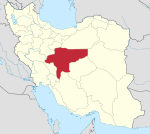| Emamzadeh Esmaeil and Isaiah mausoleum | |
|---|---|
 | |
| Religion | |
| Affiliation | Shia Islam |
| Province | Isfahan |
| Location | |
| Location | Isfahan, Iran |
| Municipality | Isfahan |
| Geographic coordinates | 32°39′47″N 51°41′09″E / 32.663186°N 51.685767°E |
| Architecture | |
| Type | Imamzadeh |
| Specifications | |
| Dome(s) | 2 |
| Minaret(s) | 1 (ruined) |

Emamzadeh Esmaeil (Persian: امامزاده اسماعيل) is a historical complex in Isfahan, Iran, which dates back to the Seljuk and Safavid era.[1] This complex is located near the Jameh Mosque of Isfahan, in the Hatef street and contains two mausoleums, one believed to be for Esmaeil, one of grandsons of Hasan ibn Ali, and another which is believed to be Isaiah's.[2]
History
Nastaliq inscription on the northern wall says that the building dates back to Imam Ali's era, but according to archeological research the building is no older than the Seljuk era. During the Safavid era, the building was completely renovated.[3][4]
Isaiah Mausoleum
The oldest part of this complex, it contains a tomb believed to belong to Prophet Isaiah. This place was also known as "Saiah Mosque".
Other burials
There are two gravestones in the Imamzadeh. One of the gravestones belongs to Zeinab ol Nissa Begum who was the daughter of the last Safavid king Ismail III. Another one belongs to a Shi'ite Muslim scholar, Hadi Mirlohi.
See also
References
- ^ iqna.ir (2018-10-08). "Emamzadeh Esmaeil in Isfahan". en. Retrieved 2022-06-07.
- ^ iqna.ir (2018-10-08). "Emamzadeh Esmaeil in Isfahan". en. Retrieved 2022-06-07.
- ^ Hosseyn Yaghoubi (2004). Arash Beheshti (ed.). Rāhnamā ye Safar be Ostān e Esfāhān(Travel Guide for the Province Isfahan) (in Persian). Rouzane. p. 116. ISBN 964-334-218-2.
- ^ "Isfahan portal". Archived from the original on 2016-03-30. Retrieved 2015-10-19.

